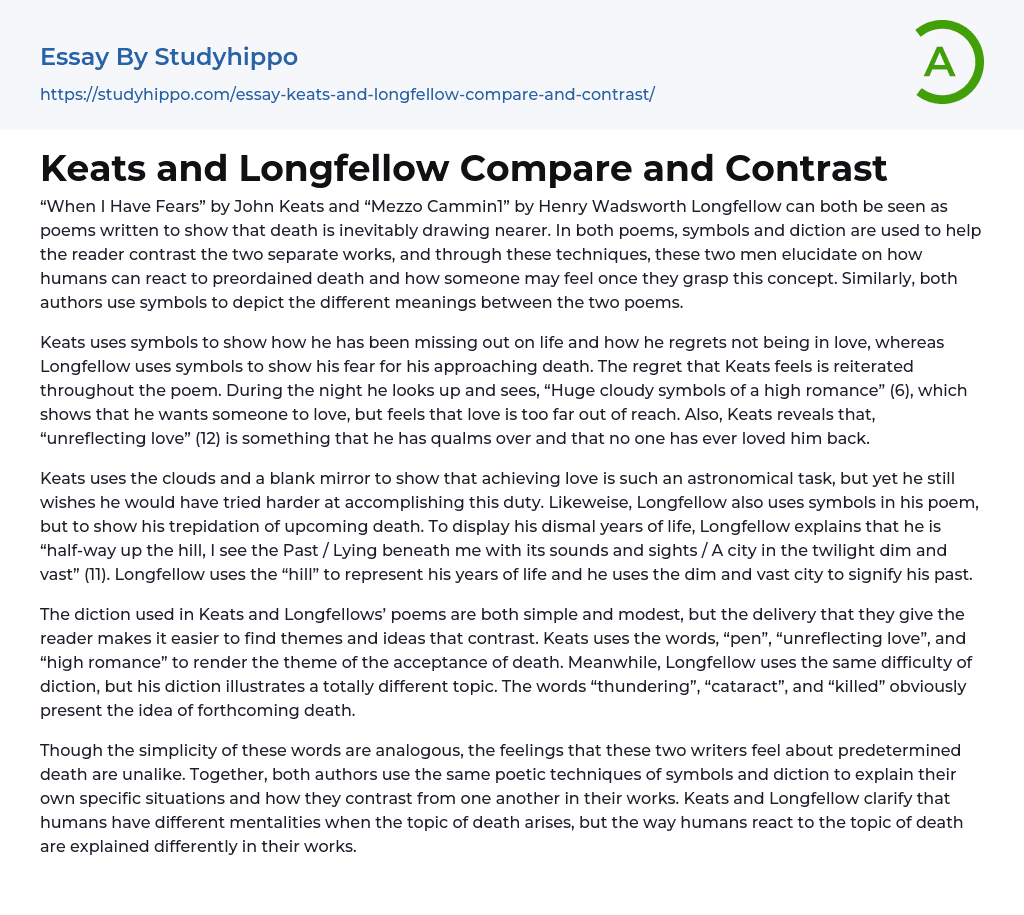“When I Have Fears” by John Keats and “Mezzo Cammin1” by Henry Wadsworth Longfellow can both be seen as poems written to show that death is inevitably drawing nearer. In both poems, symbols and diction are used to help the reader contrast the two separate works, and through these techniques, these two men elucidate on how humans can react to preordained death and how someone may feel once they grasp this concept. Similarly, both authors use symbols to depict the different meanings between the two poems.
Keats uses symbols to show how he has been missing out on life and how he regrets not being in love, whereas Longfellow uses symbols to show his fear for his approaching death. The regret that Keats feels is reiterated throughout th
...e poem. During the night he looks up and sees, “Huge cloudy symbols of a high romance” (6), which shows that he wants someone to love, but feels that love is too far out of reach. Also, Keats reveals that, “unreflecting love” (12) is something that he has qualms over and that no one has ever loved him back.
Keats uses the clouds and a blank mirror to show that achieving love is such an astronomical task, but yet he still wishes he would have tried harder at accomplishing this duty. Likeweise, Longfellow also uses symbols in his poem, but to show his trepidation of upcoming death. To display his dismal years of life, Longfellow explains that he is “half-way up the hill, I see the Past / Lying beneath me with its sounds and sights / A city in the twilight dim an
vast” (11). Longfellow uses the “hill” to represent his years of life and he uses the dim and vast city to signify his past.
The diction used in Keats and Longfellows’ poems are both simple and modest, but the delivery that they give the reader makes it easier to find themes and ideas that contrast. Keats uses the words, “pen”, “unreflecting love”, and “high romance” to render the theme of the acceptance of death. Meanwhile, Longfellow uses the same difficulty of diction, but his diction illustrates a totally different topic. The words “thundering”, “cataract”, and “killed” obviously present the idea of forthcoming death.
Though the simplicity of these words are analogous, the feelings that these two writers feel about predetermined death are unalike. Together, both authors use the same poetic techniques of symbols and diction to explain their own specific situations and how they contrast from one another in their works. Keats and Longfellow clarify that humans have different mentalities when the topic of death arises, but the way humans react to the topic of death are explained differently in their works.
- Book Summary essays
- Metaphor essays
- Reader essays
- Rhyme essays
- Literary devices essays
- Villain essays
- Books essays
- Genre essays
- Literary Criticism essays
- Writer essays
- Protagonist essays
- Simile essays
- Poem essays
- Book Report essays
- Book Review essays
- Greek Mythology essays
- Plot essays
- Tragic Hero essays
- Coming of Age essays
- Play essays
- Rhetoric essays
- Rhetorical Question essays
- Translation essays
- Understanding essays
- Reason essays
- Character essays
- Letter essays
- American Literature essays
- Literature Review essays
- Utopia essays
- Poetry Analysis essays
- Dante's Inferno essays
- Between The World and Me essays
- Incidents in The Life of a Slave Girl essays
- Flowers for Algernon essays
- Myth essays
- Everyday Use essays
- Boo Radley essays
- Genesis essays
- Richard iii essays
- Alice in Wonderland essays
- On the road essays
- Ozymandias essays
- The Nightingale essays
- Holden Caulfield essays
- Animal Farm essays
- 1984 essays
- A Hanging essays
- Shooting An Elephant essays
- A Tale Of Two Cities essays




